Propulsion Systems
-
- Optimal Electric Ship Propulsion Solution Maritime Reporter, Sep 2002 #50
Throughout the history of shipbuilding, the key challenge too often has been how to build the right ship around a given propulsion system, rather than creating tailored propulsion system for the ship. That was true when the best propulsion "engines" available were sails, and it is also true for today's diesel, gas turbine and electric hybrid systems as well.
The ideal, of course, is to allocate cargo space, cabin space, the shape of propulsion units, and even the shape of the ship's itineraries around the needs of the marketplace rather than around the limitations imposed by the ship's propulsion system. Factors that remain in the path of that ideal include the underlying efficiency across a broad operational range with which chemical energy is turned into mechanical energy, and the ability to allocate space in the most profitable manner. In other words, if you can dramatically improve the power densities of marine propulsion motors and generators as well as their efficiencies; i.e. make these efficiencies much higher and more uniform at varying loads, many of the other issues would be resolved too — and ship design need not be compromised.
In fact, with continuing improvements in power density and efficiency, electric drive propulsion systems are projected to displace mechanical drive systems across a broader spectrum of applications.
The maturation of HTS rotating machine design coupled with the upcoming U.S. Navy-sponsored 5 MW prototype motor development and testing indicate that high temperature superconducting (HTS)-based propulsion systems represent a nearterm solution to these long-standing challenges. Motors and generators employing HTS wire are very compact in size and low in weight. These qualities make them easier to site in the ship, allows more modular ship construction, and reduces undesirable tradeoffs that face many ship designers. Naval architects can now begin to translate these propulsion system improvements into increased profitability for ship owners and operators.
The Challenge Even in modern ships, propulsion systems are so large and heavy that in many applications they force the rest of the ship to be constructed around them.
Machine sizes and their locations also reduce the space available for cargo and passengers and interfere with efficient loading and unloading. Shafts can extend considerable lengths, further compromising efficient space utilization.
Additionally, the propulsion systems, both mechanical and electrical, used in virtually all ships today operate less efficiency at lower speeds — creating excess costs on shorter routes and eliminating the use of some otherwise desirable ports.
All these issues carry associated costs.
Installing propulsion systems so early in the ship's construction increases the cost of capital and reduces the builder's ability to use the most efficient shipbuilding practices. Less usable internal volume decreases the revenue generation potential for commercial vessels as well as the war-fighting capability for military ships. Inefficient loading and unloading create longer cycle times, increase port costs, and jeopardize schedules. Prolonged and low speed operation of diesel direct-drive and geared propulsion systems increases maintenance costs.
Reduced efficiency at low ship speeds may make certain shipping routes unprofitable compared with other transportation alternatives. The shift to diesel electric propulsion systems addressed some of these issues. Electric motors can be located further aft in a ship, freeing naval architects from the "tyranny of the shaft-line," giving ship designers almost unlimited flexibility in the ship arrangements. The length of the drive train is reduced, as is the requirement to maintain strict alignment requirements over long lengths from the prime mover to the propeller. For ships that incorporate podded propulsors, this length is reduced to zero. These externally mounted motors maximize a ship's hydrodynamic efficiency and its usable internal volume for revenue generation.
Podded propulsors also reduce shipbuilding costs through increased modularity during construction. Ships today tend to consume more electricity than did their predecessors. Integrated electric propulsion systems optimize ship operators' flexibility through the ability to only use the minimum amount of electricity generation equipment for a given operational scenario. The generators may therefore be operated closer to their full outputs and unneeded machines shut down, which increases the overall system efficiency and minimizes maintenance requirements.
It is because of advantages like these that nearly all cruise ships and many other ship types including shuttle tankers, product carriers, ferries, icebreakers, and offshore oil exploration platforms have made the transition to integrated electric propulsion systems, in both in-hull and podded propulsion variants. In addition, 13 navies of the world have either modern electrically propelled ships, are already designing/constructing electrically propelled ships, or have announced plans to initiate such programs.
Prominent among these is the U.S. Navy, which in 2000, announced that its next generation of surface combatant ships will have electric propulsion systems.
Although they are an improvement over their predecessors, modern electric drives still have not presented an ideal propulsion solution for shipbuilders across a wide range of applications. Electric propulsion motors at higher power levels can be large and heavy, which limits their flexibility in placement within the ship. In propulsion pod applications, this large size and weight provide an upper bound to the pod's applicability, apparently around 20 MW. In addition, today's electric propulsion motors have significantly reduced efficiencies at lower ship speeds, thereby failing to take best advantage of one of their primary attributes — reduced fuel consumption when compared to low speed diesel engines operated at low power levels.
Improving Energy Transformation Efficiency and Power Densities Unlike the force of gravity or the speed of light, the efficiency of mechanical/electrical energy transformation is not a universal constant. Efficiency is a function of variables that have been well known for decades, including the geometry of the motor or generator, the presence or absence of an iron core in its rotor, the material from which the wire in the rotor coils is composed and so forth. In fact, the variable found to have the biggest impact on efficiency is the rotor coil winding material.
The maturation of electrically loss-less ceramic materials, known as high temperature superconducting (HTS) wires, has dramatically improved rotating machine efficiencies, and allowed their designs to be modified so that they can now be built at a fraction of previous sizes and weights.
Just as optical fiber transmits data much better than copper does, so too can ceramic fila filaments transmit electricity much better than copper. The difference is that optical systems must plug into special adaptive electronics, while motors and generators using HTS wire plug into the same grid and operate in exactly the same way as their copper-based counterparts.
Electric propulsion motors using coils made with HTS wires are just a lot lighter and smaller for a specified power output, and more efficient at all loads.
This makes them easier to site in the ship, allows more modular ship construction, and reduces undesirable tradeoffs that face many ship designers. HTS motors in larger power ratings will fit easily into external pods, for example, and therefore simplify the shipbuilding process. The only consideration for these HTS motors and generators is that they require a small, commercially available refrigeration system to cool the HTS wires. These refrigerators are similar but less complex than those used satisfactorily in thousands of medical diagnostic equipment worldwide.
These cooling compressors give new meaning to the term "hot swappable" as they are easily stocked and field-replaceable — even when the generator or motor is running — and they occupy the space of a singledrawer file cabinet. HTS motors and generators are designed typically with "n + 1" refrigeration system redundancy to preclude presenting an operational limitation to the ship operator. In addition, the power consumption of these refrigerators is negligible relative to the output of the generator or motor. The reason HTS motors and generators are so efficient is that HTS wire can carry up to 140 times more current than the copper wire of the same size and weight. More current means greater flux density, more powerful magnetic fields and in the case of motors, more torque per unit mass of the machine. HTS motors and generators can therefore be much lighter and smaller, not only because the wire inside them is smaller and lighter, but also because they produce more powerful magnetic fields.
HTS motors also have another advantage: their high efficiency is a constant across virtually their entire power range. Figure 2 (below, left) compares the calculated efficiency of a typical HTS synchronous marine propulsion motor with equivalent conventional marine propulsion synchronous and induction motors.
The calculations also include the losses from the motor cooling system. This means motors and generators can operate at close to maximum efficiently regardless of the ship's speed, creating savings that flow directly to the operators' bottom line. In one study, it was shown that in some scenarios HTS electric propulsion systems can achieve fuel and lube oil cost parity with diesel direct drive ships.
Size/Weight/Power Comparisons The implications of these advantages for shipbuilders are far-reaching — especially since they apply to both the generator and the motor. Compare, for example, the weight and size of a variety of HTS and conventional synchronous motors ranging in power ranges from 5 to 90 MW, and at slow speeds as required for marine propulsion. All are 4.2 KV machines. Figure 3 (previous page) shows a weight versus power comparison for the two technologies.
Figure 4 shows a size versus power comparison. The size comparisons also include maintenance volume, allowing one meter all around the HTS motor (except the bottom) and two meters all around the much larger conventional motor (again, except the bottom).
The weight savings advantage achieved by HTS motors is particularly valuable in pod applications. It has been estimated that for every 500 tons less light ship weight, about 40 more containers can be carried. Thus, a container ship using HTS podded propulsors will be able to carry about 2.5 to 4 percent more containers.
Complementing their light-weight and compact size, HTS motors can be optimized around specific dimensional requirements. These requirements may include minimizing a propulsion motor's diameter to maximize the hydrodynamic performance of a propulsion pod or to create increased cargo capacities in ships/ lower decks, or maximizing the machine's efficiency. The machines' reduced size creates volume and deck savings that are advantageous in virtually all types of ships, both military and commercial.
Likewise, HTS generators will be much smaller and lighter than their conventional counterparts. In fact, HTS generators enjoy an additional advantage: they operate with greater efficiency than their conventional counterparts even when the refrigeration requirements are considered.
With such small motors and generators, ship machinery space allocations become much less restrictive — making room for more revenue producing volume and allowing for highly innovative designs. Consider for example a 25 MW HTS generator. Coupled with a marine gas turbine engine at about 17 tons, the overall unit could weigh less than 50 tons. This might be light enough in some ships to mount the system in the deckhouse, offering much more revenue space below, better turbine efficiency, and better maintenance access which may, in some instances, offset the drawbacks of environmentally friendly but relative inefficient gas turbines.
Such small and light HTS electric motors might, for example, enable more efficient electric drive pump-jet systems and hydrodynamically optimized pod drives that offer better efficiency and higher power than is achievable with conventional motors.
As noted earlier, HTS propulsion systems have the additional advantage of being able to operate just as efficiently down to low speeds, which is especially important for cruise ships, coastal merchant ships and warships that spend much of their time operating at partial loads. Overall, the fuel savings from efficiency gains of HTS machines depend on the operating scenario but preliminary calculations suggest that fuel savings from $100,000 to $500,000 per ship per year can be expected for many ship types.
Other Advantages There are other advantages of HTS machinery as well. Because there is little or no iron in the magnetic path of the motor or generator, there is very little distortion in the power supply and little noise feedback from the motor. This should simplify power-conditioning system requirements and make for extraor- dinarily quiet machinery (both electrically and acoustically). The lower weight of the generator rotor also reduces noise.
In other respects, HTS machines behave like conventional electric machines. Their magnetic field can be dumped quickly in case of a system casualty, just like in a conventional synchronous motor or generator. They can be operated with existing synchroconverters, cycloconverters or PWM converters, although some simplification of these systems may be possible in order to take advantage of the lower distortion.
The machines' low weight and small size allow them to be shipped and installed intact, rather than having to be built and tested at the factory, disassembled for shipment to the shipbuilder, and then reassembled and tested at the building yard prior to installation.
Preliminary pricing evaluations indicate that HTS motors and generators should be commercially available at prices equivalent to conventional machines but be easier and less expensive to install — and could be installed later in the ship's construction.
The View Forward So what's next for HTS and how soon will it be widely deployed? HTS wire has been extensively tested in Navy and commercial laboratories, and its durability has been proven. HTS motors rated up to 5,000 hp at 1,800 rpm have been built and tested successfully to a continuous rating of 5.900 hp.
A 230-rpm, 5 MW ship propulsion prototype motor, funded by the U.S.
Navy's Office of Naval Research, is now being built at American Superconductor Corporation, and will be rigorously evaluated by the U.S. Navy in the last half of 2003. A 100 MVA HTS commercial generator, funded in part by the U.S.
Department of Energy, is under development at General Electric. From this view, it appears that HTS-based propulsion systems are the next generational improvement in marine propulsion systems.
Naval architects can now begin to translate these propulsion system improvements into increased profitability for ship owners and operators.
Circle 7 8 on Reader Service Card www.maritimereporterinfo.com About the Author Stuart C. Karon is Director, Government Programs and Director, Business Development for the Electric Motors and Generators Business Unit at American Superconductor.
Formerly a U.S. Navy Officer and subsequently marketing & sales director in the commercial sector, Karon is responsible for structuring effective government-funded R&D and system design/development programs, and for bringing about the business relationships necessary for the American Superconductor Corporation Electric Motors and Generators Business Unit to achieve its objectives. He can be reached at Skamn @Amsuper. Com.
-
- Propulsion Systems Appoints Eagle Marine Sales Representative Maritime Reporter, Mar 15, 1977 #37
P.K. Wennberg, president of Propulsion Systems, Inc., Kent, Wash. 98031, has announced the appointment of Eagle Marine, Inc. as PSI sales representative, covering Florida and Georgia. The agreement covers PSI's product lines of PSI/Liaaen controllable- pitch propellers and thrusters; PSI/Frydenbo
-
- Propulsion Systems, Inc. Appoints John Phinney Engineering Manager Maritime Reporter, Jun 1977 #55
P.K. Wennberg, president of Propulsion Systems, Inc., has announced the appointment of John M. Phinney as manager of engineering. PSI, based in Kent, Wash., o f f e r s PSI/Liaaen Controllable Pitch Propellers and Thrusters, PSI/Frydenbo Rotary Vane Steering Gear, Brunvoll Thrusters, Rate Conn
-
- Propulsion Systems, Inc. Expands Thruster Line Maritime Reporter, Jul 1977 #14
Propulsion Systems, Inc. of Kent, Wash., has entered the small thruster field with 16 and 24-inch-diameter tunnel thrusters. In these thrusters, the propeller shaft is driven directly by a hydraulic motor contained in the unit. Each of these two thrusters is available with three different hydraulic
-
- ZF Marine Propulsion Systems Maritime Reporter, Sep 2013 #14
fields that it serves. While the company reaps the majority of its sales in the automotive sector, it is making a concerted push through its Marine Propulsion Systems unit to expand its offering and presences in the commercial maritime business. Wolfgang Schmid, Head of Marine Propulsion Systems Regional North
-
- Innovative Propulsion Systems for Fast Craft Marine News, Jul 2014 #40
transfer high torque diesel power. Serial pre-production of the OXE diesel outboard engine is planned to commence in mid 2015.” Engines and propulsion systems that are designed and built for professional or commercial operations need to run hard, often for long hours in adverse sea conditions. Users
-
- MN 100: ZF Marine Propulsion Systems Marine News, Aug 2014 #74
edward.schwarz@zf.com Website: www.zfmarinecc.com CEO/President: Wolfgang Schmid Number of Employees: 100 The Company: ZF Marine supplies propulsion system components for yachts, defense craft, high-speed ferries, workboats and commercial vessels, in a power range from 10 to 14,000 kW. The product
-
- THE LATEST ADVANCEMENTS IN PROPULSION SYSTEMS FOR TODAY'S NAVIES Maritime Reporter, Sep 1988 #40
and components in an effort to provide the international naval market with the most durable, quietest, most powerful and most fuel-efficient propulsion systems. This article offers a brief review of some of the latest propulsion systems that are in use by the world's naval fleets. Technical reports
-
- Electric Propulsion Systems Discussed At SNAME Chesapeake Section Maritime Reporter, May 15, 1981 #20
Architects and Marine Engineers, was held at the Walter Reed Army Medical Center in Washington, D.C., and featured a presentation on electric propulsion systems for naval combatants by Capt. James V. Jolliff of the Naval Sea Systems Command. Electric propulsion has proven quite successful in
-
- Michigan Wheel Announces Formation Of Propulsion Systems Group Maritime Reporter, Aug 15, 1980 #18
H.L. VanderMey, president of the M i c h i g a n Wheel Division, Dana Corporation, has announced the formation of a propulsion systems group to market new systems for the increased propulsive and maneuverability efficiency of marine vessels. The systems involved in the new group will be composed of
-
- MN100: ZF Marine Propulsion Systems Marine News, Aug 2016 #90
The Company: ZF Marine supplies propulsion system components for yachts, defense craft, high-speed ferries, workboats and commercial vessels, in a power range from 10 to 14,000 kW. The product portfolio includes a comprehensive range of transmissions (reversing, non-reversing and hybrid), propellers
-
- Alternative Ferry Propulsion Systems: A Case Study Marine News, Mar 2017 #24
serves many ferry customers in North America. These clients read the trade publications and see various articles on new technologies such as hybrid propulsion, battery powered vessels or zero emission vessels. After finishing such an article they ask themselves: “What advantages would that technology bring
-
 )
June 2025 - Maritime Reporter and Engineering News page: 13
)
June 2025 - Maritime Reporter and Engineering News page: 13, retro? ts, including the addition of battery storage, fuel cells, but when applied across thousands of operational hours, the or hydrogen-based propulsion systems. In an industry where savings become substantial. Over the course of a year, a 3 retro? tting can be expensive and disruptive, this forward- MW
-
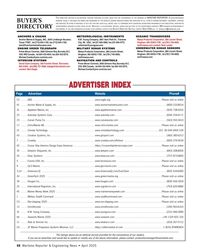 )
April 2025 - Maritime Reporter and Engineering News page: 48
)
April 2025 - Maritime Reporter and Engineering News page: 48. . . . . . . . . . . . .www.wkdoors.com . . . . . . . . . . . . . . . . . . . . . . . . . . . . . . . . . . . . .(203) 267-5712 C4 . . . . .ZF Marine Propulsion Systems Miramar, LLC . . . . . . . . . . . . . . .https://aftermarket.zf.com . . . . . . . . . . . . . . . . . . . . . . . . . . . .1 (833) ZFWRENCH The
-
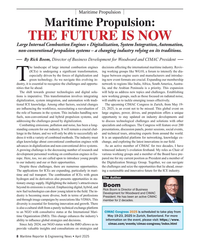 )
April 2025 - Maritime Reporter and Engineering News page: 8
)
April 2025 - Maritime Reporter and Engineering News page: 8Propulsion: THE FUTURE IS NOW Large Internal Combustion Engines + Digitalization, System Integration, Automation, non-conventional propulsion systems – a changing industry relying on its traditions. By Rick Boom, Director of Business Development for Woodward and CIMAC President he landscape
-
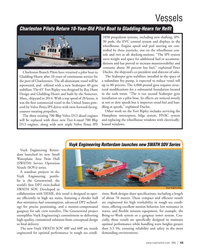 )
March 2025 - Marine News page: 43
)
March 2025 - Marine News page: 43Vessels Charleston Pilots Return 10-Year-Old Pilot Boat to Gladding-Hearn for Re? t 1050 propulsion systems, including new shafting, IPS- 30 pods, the EVC control system and displays in the wheelhouse. Engine speed and pod steering are con- trolled by three joysticks, one on the wheelhouse con- sole and
-
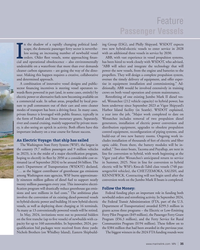 )
January 2025 - Marine News page: 35
)
January 2025 - Marine News page: 35with an additional three vessels in service by 2030. I orders. Older ? eet vessels, some approaching ? nan- ABB, with vast experience in vessel propulsion systems, cial and operational obsolescence – also environmentally has been hired to work closely with WSDOT, who advised, undesirable on a waterfront
-
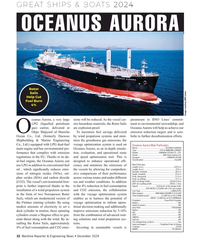 )
December 2024 - Maritime Reporter and Engineering News page: 32
)
December 2024 - Maritime Reporter and Engineering News page: 32our OOkpo Shipyard of Hanwha To maximize fuel savings delivered emission reduction targets and is sym- Ocean Co., Ltd. (formerly Daewoo by wind propulsion systems and mini- bolic to further decarbonization efforts. Shipbuilding & Marine Engineering mize the greenhouse gas emissions, the Co., Ltd.) equipped
-
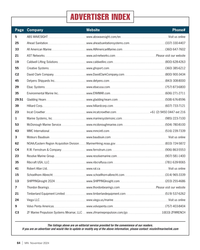 )
November 2024 - Marine News page: 64
)
November 2024 - Marine News page: 64.com (519) 537-6262 24 Viega LLC www.viega.us/marine Visit us online 9 Volvo Penta Americas www.volvopenta.com (757) 403-8404 C3 ZF Marine Propulsion Systems Miramar, LLC www.zfmarinepropulsion.com/go 1(833) ZFWRENCH The listings above are an editorial service provided for the convenience of our readers
-
 )
October 2024 - Marine News page: 29
)
October 2024 - Marine News page: 29. To keep it cleaner, offshore wind developers are also look- ing into greener technologies for tugs, barges, and WTIVs – namely, hybrid or electric propulsion systems, and alterna
-
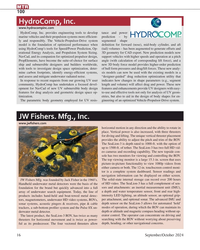 )
September 2024 - Marine Technology Reporter page: 16
)
September 2024 - Marine Technology Reporter page: 16MTR 100 HydroComp, Inc. www.hydrocompinc.com HydroComp, Inc. provides engineering tools to develop tance and power marine vehicles and their propulsion systems more ef? cient- prediction – by ly and responsibly. The Vehicle-Propulsor-Drive system segmented shape model is the foundation of optimized
-
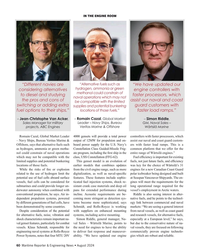 )
August 2024 - Maritime Reporter and Engineering News page: 60
)
August 2024 - Maritime Reporter and Engineering News page: 60in Arctic waters. conventional propulsion, he says. Air in- incline. Acoustic requirements are be- Riddle is also seeing interest in alter- dependent propulsion systems, powered coming more stringent as detection sys- native fuels, and he points to the technol- by different generations of fuel cells, have tems
-
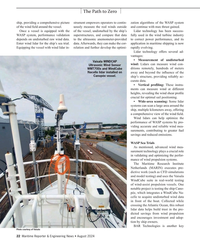 )
August 2024 - Maritime Reporter and Engineering News page: 22
)
August 2024 - Maritime Reporter and Engineering News page: 22WASP Sea Trials As mentioned, advanced wind mea- surement technology plays a crucial role in validating and optimizing the perfor- mance of wind propulsion systems. The Maritime Research Institute Netherlands (MARIN) executes pre- dictive work (such as CFD simulations and model testing) and uses the Vaisala
-
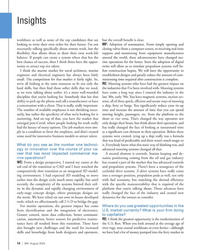 )
August 2024 - Marine News page: 14
)
August 2024 - Marine News page: 14rms have the oppor- rine operations for the better. Soon the adoption of digital tunity to attract top tier talent. twins will allow us to simulate propulsion systems well be- I think the marine market for naval architects, marine fore construction begins. We will have the opportunity to engineers and electrical
-
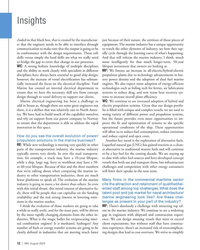 )
August 2024 - Marine News page: 12
)
August 2024 - Marine News page: 12been a challenge to WC: We continue to see increased adoption of hybrid and add in house as, though there are some great engineers out electric propulsion systems. Given that our design portfo- there, it is a skillset that was relatively rare in North Amer- lio is ? lled with unique and complex vessels
-
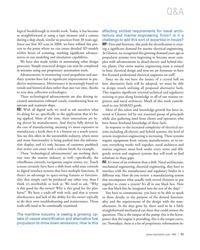 )
August 2024 - Marine News page: 11
)
August 2024 - Marine News page: 11, marking signi? cant advance- At Glosten, we recognized this growing demand years ago as ments in our modeling and simulation capabilities. propulsion systems were beginning to become more com- We have also made strides in automating other design plex with advancements in diesel-electric and hybrid-elec- pr
-
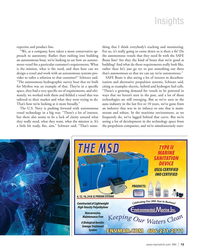 )
June 2024 - Marine News page: 13
)
June 2024 - Marine News page: 13said. SAFE Boats is also seeing a lot of interest in decarbon- “The autonomous hydrographic survey boat that we built ization and alternative propulsion systems, Schwarz said, for Mythos was an example of that. They’re in a speci? c citing as examples electric, hybrid and hydrogen fuel cells. space
-
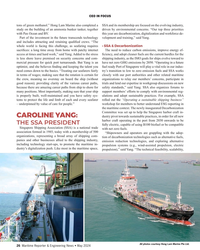 )
May 2024 - Maritime Reporter and Engineering News page: 26
)
May 2024 - Maritime Reporter and Engineering News page: 26to the shipping industry, emission reduction technologies, and exploring alternative including technology start-ups, to promote the maritime in- propulsion systems (e.g., wind-assisted propulsion, electric dustry’s digitalization push. Like most in the maritime space, propulsion),” said Yang. “The technical
-
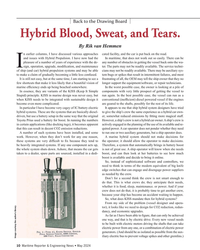 )
May 2024 - Maritime Reporter and Engineering News page: 10
)
May 2024 - Maritime Reporter and Engineering News page: 10, operation, upgrade, modi? cation, and maintenance ter. The parts may not be readily available. The service techni- of ship (and car) hybrid propulsion systems and may be able cians may not be readily available. There may be auxiliary sys- to make a claim of gradually becoming a little less confused
-
 )
March 2024 - Marine Technology Reporter page: 41
)
March 2024 - Marine Technology Reporter page: 41full-HD underwater lision avoidance through a front-looking sonar system. cameras—one forward-facing at a 45-degree angle and one The hardware and propulsion systems were redesigned with downward-facing—equipped with dimmable LED lights, pro- next-generation components for optimal performance. The vide a
-
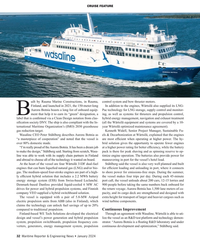 )
January 2024 - Maritime Reporter and Engineering News page: 32
)
January 2024 - Maritime Reporter and Engineering News page: 32and Denmark-based Danfoss provided liquid-cooled 6 MW AC 900 people before taking the same numbers back onboard for drives for power and hybrid propulsion systems, and Finnish the return voyage. Aurora Botnia has 1,500 lane meters of ca- company VEO supplied a hybrid switchboard solution. pacity, and its
-
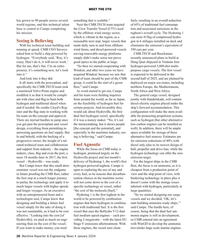 )
January 2024 - Maritime Reporter and Engineering News page: 26
)
January 2024 - Maritime Reporter and Engineering News page: 26? rst con? guration will make the stern avail- his team on the concept and approval. dual fuel hydrogen vessel, speci? cally able for pioneering propulsion systems, There are myriad hurdles to jump once if it was a money maker. “No, it’s not such as hydrogen (but other alternative you get past the powerplant
-
 )
December 2023 - Maritime Reporter and Engineering News page: 17
)
December 2023 - Maritime Reporter and Engineering News page: 17sustainable aspects of ships, including ef? cient hull or inland water vessels that stay within the bounds of a single designs and alternative propulsion systems. Digital transfor- country or zone are better candidates for full automation, or at mation could not be happening at a better time. least further
-
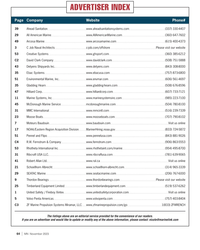 )
November 2023 - Marine News page: 64
)
November 2023 - Marine News page: 64Safety / Fireboy Xintex www.unitedsafetycorporation.com Visit us online 5 Volvo Penta Americas www.volvopenta.com (757) 403-8404 C3 ZF Marine Propulsion Systems Miramar, LLC www.zfmarinepropulsion.com/go 1(833) ZFWRENCH The listings above are an editorial service provided for the convenience of our readers
-
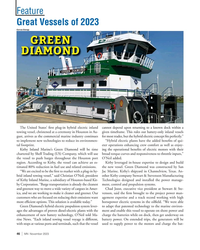 )
November 2023 - Marine News page: 46
)
November 2023 - Marine News page: 46Kir- Technologies designed and installed the power manage- by Corporation. “Barge transportation is already the cleanest ment, control and propulsion systems. and greenest way to move a wide variety of cargoes in Amer- Chad Joost, executive vice president at Stewart & Ste- ica, and we are working to
-
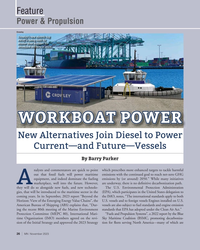 )
November 2023 - Marine News page: 26
)
November 2023 - Marine News page: 26of the Marine Environment standards that EPA has adopted under the Clean Air Act.” Protection Committee (MEPC 80), International Mari- “Fuels and Propulsion Systems”, a 2022 report by the Blue time Organization (IMO) members agreed on the revi- Sky Maritime Coalition (BSMC, promoting decarboniza- sion of
